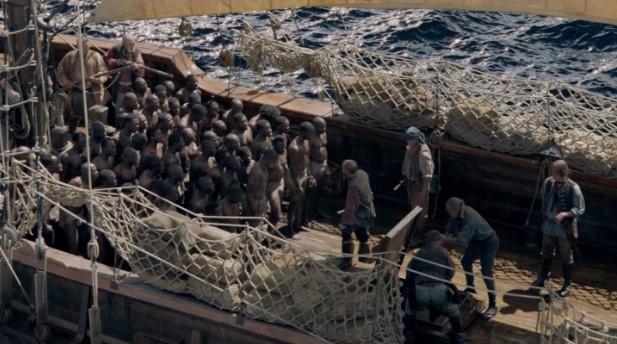American Historical Sites Hold Dark Slave History

American history is rich in war, independence and slavery, the latter often glossed over in many historic places.
Many plantations built on the back of enslaved people hold places on the National Register of Historic Places. However, the government's official record of places with historic significance mentions nothing about slavery.
Written entries on historic plantations tend to say almost nothing about the people who did manual labor picking cotton and tobacco or cutting the sugar cane that provided finances for ornate homes that now serve as wedding venues, bed-and-breakfast inns, tourist attractions, and private homes.
The modern-day Fort Monroe has nothing about the colonial ship bearing America's first Africans, the moment that inaugurated slavery across the country. The removal of an arch that spelled "Jefferson Davis Memorial Park" took place in 2019 prior to the 400th anniversary of the arrival of the first enslaved Africans.
There are over 95,000 sites listed in the National Register of Historic Places that are important to the country's story. Places such as George Washington's Mount Vernon estate to plantation homes in the rural south have register entries that mention slavery in passing or completely ignore it.
Many of the country's historic monuments have glossed over the cruel realities of slavery and racism.
The National's Registry's entry for Mount Vernon, which housed over 300 enslaved black people, doesn't use the word "slave," despite employing people to work the first president's fields, cook his food, and clean his house.
Monticello, Thomas Jefferson's mountaintop home, also avoids discussing details of their ownership of as many as 200 slaves.
Other plantations across the former Confederate states are also known to omit the dark history of slavery from their entries.
The Whitney Plantation Museum near New Orleans is one of the few plantations that open discussions about topics other plantations tend to ignore. It draws tens of thousands of visitors annually. Its entry, however, does not include any mention of slaves.
Sites from Virginia and Kansas are now facing problems with how to portray the dark histories of the former presidents' enslavement of other humans.
Attempts to retell the stories of the history of slavery have been met with pushbacks as some people prefer sanitizing America's past.
Associate professor at Ohio State University Hasan Kwame Jeffries says the incomplete stories in the National Register of Historic Places reflect the way the public ignores the topic of slavery. "It's telling us what we have been valuing as a society and how we understand slavery."
Terry Brown, a National Park Service superintendent, said the absence of black history at historic sites bothered him. "We live in a great country, but we are going to be even better when we figure out that the true part of our history involves a number of mixed cultures," he said. "A great nation remembers its history and embraces all the complexities of it."
A listing on the National Register, which was established under a 1966 historic preservation act, helps property owners in preserving their listings.
The Beginning of a Dark Past
Two decades ago, a researcher found documents in the Spanish national archive that told of a raid by two pirate ships in July 1619. The raids included that of a slave ship, which was to become the first recorded arrival of enslaved Africans in Virginia.
The enslaved Africans were villagers kidnapped from what is present-day Angola and forced into a Portuguese ship the San Juan Bautista which was bound for what the Europeans called the New World.
More than 350 Angolans were on the ship, chained head to foot below deck. They were bound for Mexico to work in the mines.
The ship came under attack in the Bay of Campeche. English pirates, who were searching for gold and silver, found the prisoners instead and stole the Angolans before docking at Point Comfort in 1619, in the settlement that would become Virginia.
Widower of Pocahontas and tobacco planter John Rolfe noted their arrival, saying it "brought not anything but 20, and odd, Negroes, which the Governor and the Cape Merchant bought for victuals(provisions)."
Some of the new arrivals were skilled. The tobacco crop was also fast becoming profitable and labor-intensive. According to a written document by the governor of Bermuda, slaves were "the most proper and cheap instruments" for raising tobacco.
Workers soon outnumbered owners who viewed black slaves as more profitable than white servants.
State legislators passed laws to marginalize and control the enslaved, such as:
In 1640, Virginia's General Assembly required free white men to arm themselves. Masters were also required to supply white servants with arms. The blacks, however, were forbidden to own weapons.
In 1642, black women were separated from indentured white women and were classified taxable.
It is estimated at least 12.5 million people were captured from Africa for the international slave trade from 1501 to 1875.
Slavery began to end at a small town on Kansas River were pro-slavery supporters once wrote an 1857 constitution that aimed to legalize ownership of other humans in the territory.
The document was ultimately rejected by Kansas' voters and the US House of Representatives in 1858.
After Republican candidate, Abraham Lincoln was elected as president, his anti-slavery views were established. Abolition became a goal after military necessity, growing anti-slavery sentiment in the North, and the self-emancipation of many people who fled enslavement in the South.
Lincoln issued a preliminary emancipation proclamation on September 22, 1862. He officially freed all slaves from any State on January 1, 1863.
Though slavery didn't officially end after the proclamation, it would end after the Civil War in 1865 through the passage of the 13th Amendment. The amendment officially abolished slavery on December 18, 1865.
Enslaved men and women received rights and citizenship in the 14th Amendment and the right to vote in the 15th Amendment.
Subscribe to Latin Post!
Sign up for our free newsletter for the Latest coverage!

















